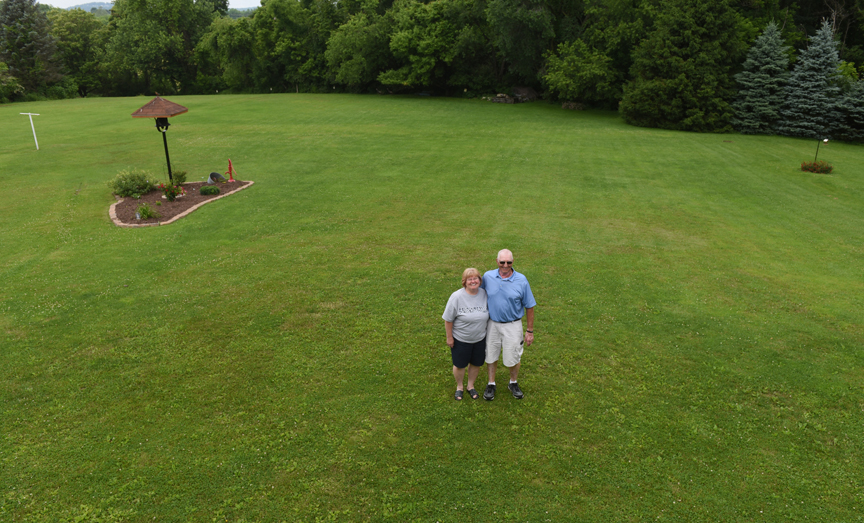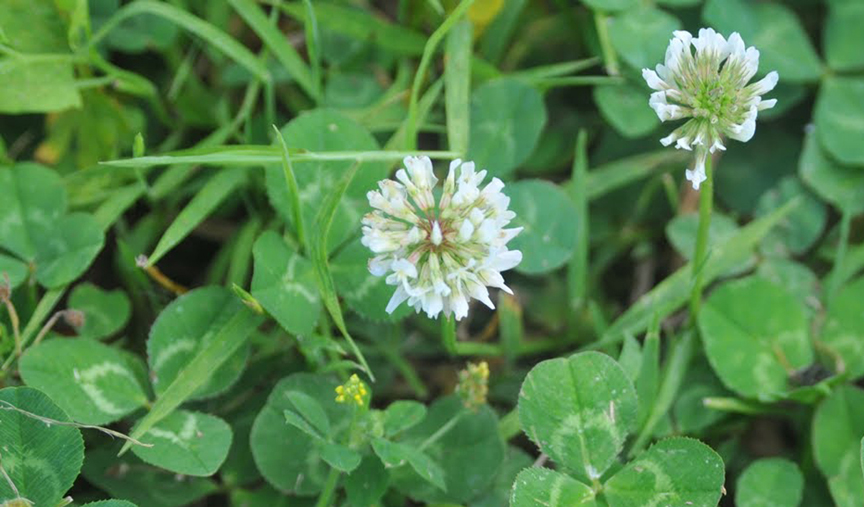Organic lawn for local couple brings satisfaction
Posted on: July 25, 2019 | Written By: Doug Oster |
Kathy Fajt told her husband Gene that something needed to be done about their lawn. For more than six years Gene had struggled with the grass at their Unity Township, Westmoreland County home near Latrobe. He would add lime, figuring that was a good thing, but it wasn’t helping.
That’s when I got a message from Kathy. I told her to call me, because there’s a lot to talk about when explaining how the lawn can be brought back to its former glory. She listened, taking notes as I talked about soil tests, organic fertilizer, aerating and more.
When she presented the information to her husband, he was completely receptive. “Well, I need to figure out where to get this stuff,” he related while retelling the story from the couple’s back deck.

Kathy and Gene Fajt of Unity Township, Westmoreland County followed Everybody Gardens editor Doug Oster’s advice and got help from the Penn State Cooperative Extension to get a great lawn.
The first thing they did was get a soil test kit from the Westmoreland County Penn State Cooperative Extension (all Pennsylvania counties offer the test kits). After digging up soil samples, they were sent the Penn State test lab. After reading through the results and consulting their local extension agent, Gene realized he needed to add much more lime than he had been applying to get the soil pH in line. With support from the extension agent, he’ll be doing another application later in the season.
“I’m going to keep going,” he said with a smile. “More lime this fall.”
When the pH is corrected to around 6.5, the grass will be able to absorb nutrients it needs from the soil. His next step included adding organic fertilizers like Gardentone from Espoma and dehydrated chicken manure. He also did some reseeding. Young grass seedlings can invigorate a lawn that has the right pH and fertility levels.
“We had a lot of bare spots before he started this,” Kathy added. That was in addition to mud all along the edge of the front yard.
The couple is using only organic products and techniques to improve the lawn.
“We live on well water so I’m not using anything that’s going to harm us,” Gene says.
He’s also going to cut the grass a little higher, moving from three inches to three and a half. That tall grass will help shade out weeds. “I’ll move it up one more notch,” he said of his mower level. The trimmings aren’t bagged anymore either; they are left on the lawn to decompose and add a natural fertilizer to the area.
Gene was amazed when I told him clover was actually a great thing for the grass. In years past, clover was always included in grass seed as the two have a symbiotic relationship. The clover pulls nitrogen from the air and makes it available at the root level for the lawn.
“I’m going to leave that alone,” he says laughing. “I thought that was a weed.”

Love your clover!
Another thing I recommended was renting an aerating machine this fall. It takes thumb-sized plugs out of the turf to reduce compaction. The remaining holes will allow water and fertilizer to get down to the root zone of the lawn.
He’s dealing with the problems many homeowners have when trying to get a better-looking lawn. The grass is growing in clay and/or shale, so the organic fertilizer will help amend the soil over time.
Gene had some questions for me too, specifically about the organic weed control called corn gluten meal. It’s a byproduct of the corn milling process and is a safe way to deal with many weeds, but gardeners need to understand how it works after applied. Once seeds germinate (any seeds, not just weed seeds), the corn gluten meal dries them out and they can’t continue to grow. The product has no effect on already existing weeds. It’s applied early in the spring, when the forsythia blooms (that’s the signal that crabgrass and other annual weeds have not sprouted yet). It’s also applied again in the fall.
The most common chemical lawn herbicide, 2,4-D, which was a major component of Agent Orange, is something the couple wants nothing to do with.
“Because we live off well water and I know that stuff is not good for you,” Gene says.
“We try to do everything naturally and organically,” Kathy adds.
Doug Oster is editor of Everybody Gardens, a website operated by 535Media, LLC. Reach him at 412-965-3278 or doster@535mediallc.com. See other stories, videos, blogs, tips and more at everybodygardens.com.
Phipps Conservatory and Botanical Gardens safe lawn and landscaping program is a way for homeowners to find a service that uses organic and sustainable practices to care for a lawn.
More from Everybody Gardens
Electric lawnmowers are quiet, light, powerful and good for the environment.